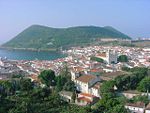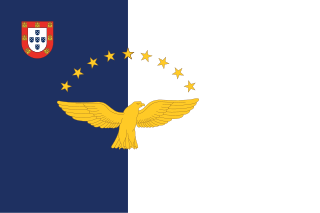
The Azores, officially the Autonomous Region of the Azores, is one of the two autonomous regions of Portugal. It is an archipelago composed of nine volcanic islands in the Macaronesia region of the North Atlantic Ocean, about 1,400 km (870 mi) west of Lisbon, about 1,500 km (930 mi) northwest of Morocco, and about 1,930 km (1,200 mi) southeast of Newfoundland, Canada.

The 1383–1385 Portuguese interregnum was a war of succession in Portuguese history during which no crowned king of Portugal reigned. The interregnum began when King Ferdinand I died without a male heir and ended when King John I was crowned in 1385 after his victory during the Battle of Aljubarrota.

Praia da Vitória is a municipality in the Portuguese archipelago of the Azores. With a population of 21,035, the second largest administrative authority on the island of Terceira, it covers an area of 162.29 square kilometres (62.66 sq mi), that extends from the northern coast halfway into the interior.

Angra do Heroísmo, or simply Angra, is a city and municipality on Terceira Island, Portugal, and one of the three capital cities of the Azores. Founded in 1478, Angra was historically the most important city in the Azores, as seat of the Bishop of the Azores, government entities, and having previously served as the capital city of Portugal during the Liberal Wars. The population in 2011 was 35,402, in an area of 239.00 km2. It was classified as a World Heritage site by UNESCO in 1983.
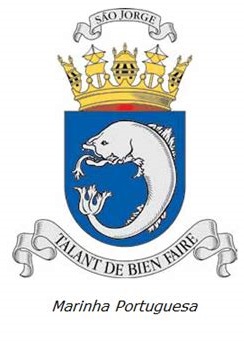
The Portuguese Navy, also known as the Portuguese War Navy or as the Portuguese Armada, is the navy of the Portuguese Armed Forces. Chartered in 1317 by King Dinis of Portugal, it is the oldest continuously serving navy in the world; in 2017, the Portuguese Navy commemorated the 700th anniversary of its official creation.
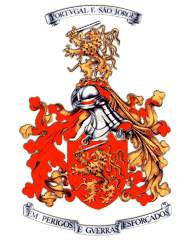
The Portuguese Army is the land component of the Armed Forces of Portugal and is also its largest branch. It is charged with the defence of Portugal, in co-operation with other branches of the Armed Forces. With its origins going back to the 12th century, it can be considered one of the oldest active armies in the world.

The naval Battle of Vila Franca do Campo, also known as Battle of Ponta Delgada and Naval Battle of Terceira Island, took place on 26 July 1582, off the coast of the island of São Miguel in the Portuguese archipelago of the Azores, during the War of the Portuguese Succession. A combined corsair expedition, mainly French, sailed against a Spanish naval force made up of Portuguese and Castilian ships, to preserve control of the Azores under the pretender António, Prior of Crato and to defend the islands from incorporation into the Iberian Union, the largest French force sent overseas before the age of Louis XIV.

Miguel António de Melo, a nobleman, colonial administrator and the 1st Count of Murça. He was young nobleman who exercised a position in the Royal court of Portugal, 14th Lord of Murça and Castro Daire, squire of Figueira, commander of Santa Maria de Freixas in the Order of Christ and honorary member of the Royal Academy of Sciences, in addition to holding several political offices, including that of governor and captain-general of Angola, minister and peer of the realm, appointed to a commission, by King John VI of Portugal, to draft a constitution for Portugal, minister and peer of the realm.
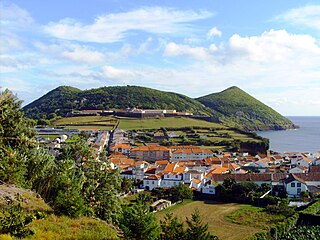
The Fortress of São João Baptista, also known as the Fort of São Filipe or Fort of Monte Brasil is a historic fortress and defensive emplacement, located in the civil parish of Sé, municipality of Angra do Heroísmo in the Portuguese island of Terceira, archipelago of the Azores.

The Battle of Salga occurred on 25 July 1581, around the Bay of Salga and along the coastal part of the parish of Vila de São Sebastião, on the island of Terceira in the Portuguese Azores, between Spanish and Portuguese forces. The latter, in the name of António, Prior of Crato, successfully defended the island against the personal union with the Spanish crown during the War of the Portuguese Succession.

The Conquest of the Azores, but principally involving the conquest of the island of Terceira, occurred on 2 August 1583, in the Portuguese archipelago of the Azores, between forces loyal to the claimant D. António, Prior of Crato, supported by the French and English troops, and the Spanish and Portuguese forces loyal to King Philip II of Spain, commanded by the Admiral Don Álvaro de Bazán, Marquis of Santa Cruz, during the War of the Portuguese Succession. The victory of the Marquis of Santa Cruz resulted in the rapid Spanish conquest of the Azores, facilitating the integration of the Kingdom of Portugal and its colonial possessions into the Spanish Empire.

The Fort of Negrito is a 16th-century maritime fort situated in the civil parish of São Mateus da Calheta, in the municipality of Angra do Heroísmo on the island of Terceira, Azores, Portugal.
The Fort of the Caninas, is a medieval fort situated in the Portugueses civil parish of Porto Judeu, municipality of Angra do Heroísmo, in the archipelago Azores.
Fort of the Cavalas is a fort situated in the civil parish of São Sebastião in the municipality of Angra do Heroísmo, in the Portuguese archipelago of the Azores.

Fort of Santa Cruz, is a 16th-century fortification located in the civil parish of Angústias, municipality of Horta, on the island of Faial in the Portuguese Azores. Occasionally referred to as the Castelo de Santa Cruz by locals, it is situated in the historic centre of the city, on the edge of Horta Bay. It was constructed to work in conjunction with the Fort of Bom Jesus at the mouth of the Ribeira da Conceição and Fort of Greta along the coast of the extinct spatter cone Monte da Guia, to defend the entrance to the harbour and southern access to the Bay.
The Fort of the Espírito Santo is the remains of a 16th-century fortification located on the extreme northern edge of the Bay of Praia da Vitória, in the Portuguese civil parish of Santa Cruz, municipality of Praia da Vitória, on the island of Terceira, in the Azores.
Brianda Pereira was an Azorean known for her role during the Battle of Salga, during the Portuguese resistance against the Spanish occupation in the archipelago, during the reign of Philip II of Spain. The name of Brianda Pereira was mythologized by the Romantic movement at the end of the 19th century, who was elevated to the status of heroine by the Estado Novo regime, affirming Portuguese nationalism. She became a popular figure and used as a protagonist of various theatre folk plays, songs and dances/marches during Carnaval, in addition to being adopted as a matron of various institutions.
Francisco Ornelas da Câmara, nobleman and Azorean politician who was instrumental in the period of the Portuguese Restoration War, being responsible for its declaration in the Azores, and his military campaign against the Spanish-occupied Fortress of São João Baptista (1641-1642).
The Fort of Greta is a fort along the promontory of Santa Catarina, on the western edge of the Bay of Mós, in the civil parish of Vila de São Sebastião, in the municipality of Angra do Heroísmo, on the Portuguese archipelago of the Azores.














